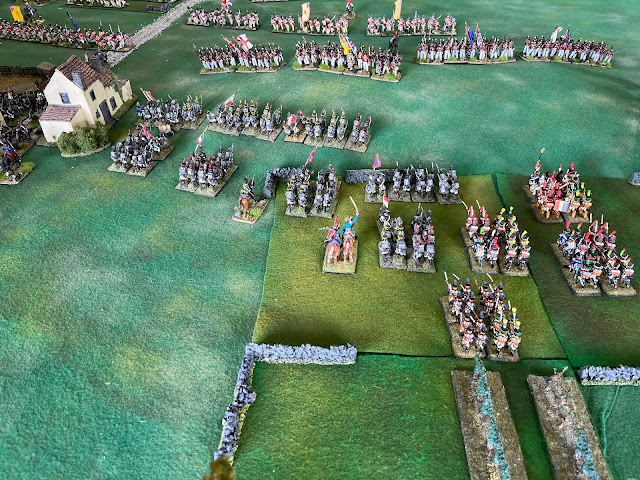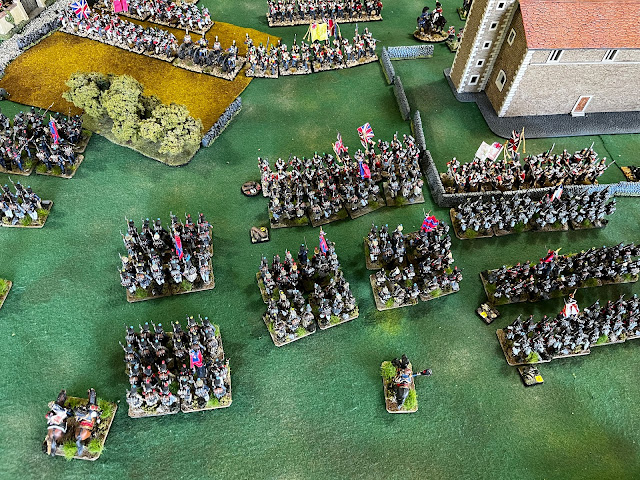Yesterday I ran a Napoleonic game based on Corunna - well the armies and the strategic situation was historically based, but the terrain and the inclusion of a Spanish force was not historical.
Background
In the winter of 1808-09 the British army is in retreat across northern Spain doggedly pursued by the French. A series of sharp rearguard actions that, combined with the harsh winter conditions, was hard on the troops. On 12 January the British arrived at the port of Corunna on the northern coast of Spain from where the Royal Navy was expected evacuate them, but the transport ships have not arrived.
The French were slow to arrive, but on the morning of the 14th they were present in force. Late that same day the first of the transports have arrived and the loading of transport, much of the artillery and some cavalry occurred that night, but much more time will be required for the whole army. The British will need to stand and fight and must hold a position until nightfall on the 15th (that is 3:30 PM on game day), when evacuation proper would begin. A stout defence was a necessity.
The Forces
The British have 22 battalions in eight brigades, five light cavalry regiments in two brigades and two small field artillery batteries. In support is a Spanish force of eleven infantry battalions, two regiments of heavy cavalry and a field battery.
The French have eight regiments of dragoons, and four of light cavalry in six brigades, 39 battalions in eight brigades and three field batteries.
Deployment
The British will deploy first at any point north of the centre line, including inside the monastery grounds (with a maximum of two battalions therein), but short of Portargo. They may deploy on the reverse slope of the long ridge (the crest will run down the centre of the ridge). Troops behind terrain do not have to be deployed until the enemy has deployed. They can hold as many units off table as they wish (the Spanish must be off table until called), but all off table units must be marked on the map where they wish them to come on. To call up off table troops in their marked position will require a die roll of 3+ first attempt, but automatically on the second attempt. If you wish to bring them on in a different location to that marked, a 5+ is required first attempt, a 3+ second attempt and they will arrive automatically on the third attempt.
The French will move onto the table from any point on the southern (bottom) edge of the map. They too may keep as many units off table as they wish, but must mark them on the map at the start of the game. To bring them on you must roll a 4+ for the first attempt, 2+ on the second attempt and automatically on the third attempt.
Victory Conditions:
Victory conditions are set entirely from a British perspective and there really is no victory to be had, merely the ability to minimise the political fallout of the evacuation. They loose points as follows:
-15 points: If 18 or more British units are disrupted, shaken or destroyed at the end of the game or
-10 points: If 12-17 British units are disrupted, shaken or destroyed at the end of the game or
-5 points: If up to 11 British units are disrupted, shaken or destroyed at the end of the game
-10 points: If they call on the Spanish force
-10 points: If more good order enemy units than good order allied units are between the two roads and north of the monastery at the end of the game.
Results:
-30 points or less Total disaster.
Only a few thousand troops have been evacuated and all supplies are lost. The Government has fallen, senior officers have been relieved of their commands. Markets have crashed and negotiations with France have commenced.
-20 to -29 points Serious defeat:
As much as half of the army and all supplies has been lost. Questions have been asked in Parliament and senior officers have been relieved of their commands.
-10 to -19 points Tactical Defeat:
While a portion of the army and most of the supplies has been lost, Horseguards is painting a rosy picture of victory through a successful evacuation, although the Prime Minister’s Office is not convinced and the press is calling for heads.
Any other result An Honourable Outcome:
The army has been successfully evacuated with a small loss of supplies. The press and the opposition are calling for an inquiry but they are drowned out by the Admiralty crowing about how it was they who saved the day by evacuating the army.
Here is how the game went.
The British made the decision to call the a Spanish from the outset and posted them on their extreme right. The other divisions deployed to the left with the cavalry off table on the centre. The French deployed their cavalry divisions on the left and the infantry to the right, with one division facing the long ridge, one between Portago and the Monastery and the third stretched from the Monastery and the cavalry.
 |
| Looking up the table with the British on the left, just after the Spanish arrived. |
 |
| The British deployment in the centre, with the monastery in the centre. |
 |
| The French right infantry division advancing against the long ridge |
 |
| The centre infantry division pressing forward through Portago |
 |
| The left division moving to the left of the monastery |
 |
| The French cavalry poised to strike. |
 |
| But the plan of the French cavalry to sweep around the Brutish right was quickly foiled by the arrival of the Spanish... |
 |
| ...who then formed a wall of squares. |
 |
| The French cavalry then spent the rest of the day trying to break the squares. |
 |
| Attack after attack went in and was beaten off. |
 |
| The French attack on the right developed quickly |
 |
| The British briefly defended the crest, but then fell back in the face of overwhelming numbers. |
 |
| The French captured the crest and looked to press down the northern face, but struggled to make headway and eventually ran out of steam. |
 |
| The I other two French divisions then became entangled in the difficult ground between Portago and the farm. |
 |
| They committed heavily to trying to storm the monastery that ultimately became their undoing. |
 |
 |
| Finally free of most of the French cavalry, the Spanish began to close in on the left of the French infantry. |



Fabulous gaming presentation, Mark. Your church as a focal point is superb. I envision this piece appearing in many theatres.
ReplyDeleteThanks Jonathan. Yes I think it will end up in many a game set in Spsin, Italy or France.
DeleteGetting the Spanish on early and then putting them in squares to foil the French flanking movement seemed like a sound strategy. The monastery was a tempting target and didn't look sufficiently defended to withstand the overwhelming French numbers, so I can understand how the got sucked into that one. It looked like a great scenario.
ReplyDeleteIf I played it again I would downgrade the Spanish. They still would have been an effective block on that flank, but might have balanced the game a bit more. I don't know what it is about big structure, but they seem to be a magnet to war gamers...they just HAVE to attack them and waste so many units trying to take them.
DeleteNice report Mark - as the British left-wing commander, I really didn't have a clear view of what happened to the French in the centre - did Rick and Barry just both roll incredibly badly when doing the "break in" roll assaulting the monastery - if I recall correctly, it was a 50/50 chance and they seemed to put in several attempts, so the law of averages should have seen one of them succeed in getting into the BUA?
ReplyDeleteThey should have just masked the monastery and concentrated on taking out the infantry in the field. They threw six battalions against that place and even if they had broken in the fight would probably have lasted the rest if the game. Yes in even numbers it is 50:50 odds, but if the attackers are stronger or weaker, the odds vary accordingly. And yes they rolled badly!
DeleteLovely - very impressive. Also love the simplicity of the map, reminds me of yesteryear (Featherstone / Grant et al)
ReplyDeleteAh ha, my quick and dirty map...knocked up in a few minutes on the PC!
DeleteA fine game and scenario there Mark and a nice compliment to Keith's earlier AAR. I smiled about big buildings being magnets to wargamers, rather like elephants in Ancients games or 'big tanks' in WWII: somehow we just can't resist attacking them!
ReplyDeleteYes Keith got ahead of me an had waaaay mod photos (but umpiring a game with 8 players kept me wel distracted from taking photos). I know that many battle involved fighting around villages and bug structures, but 9 time out of 10 the units who fought on those combats were written off...you think as gamers we would learn from history!
DeleteGreat table, great troops. Large battle with plenty of players. Maps, photos both up close and sweeping. Thanks for sharing.
ReplyDeleteThanks Joe.
DeleteFantastic stuff Mark…
ReplyDeleteWell done the Spanish…
It’s good to see them handling it out to the French…
All the best. Aly
They certainly gave the French cavalry a very bloody nose.
Delete